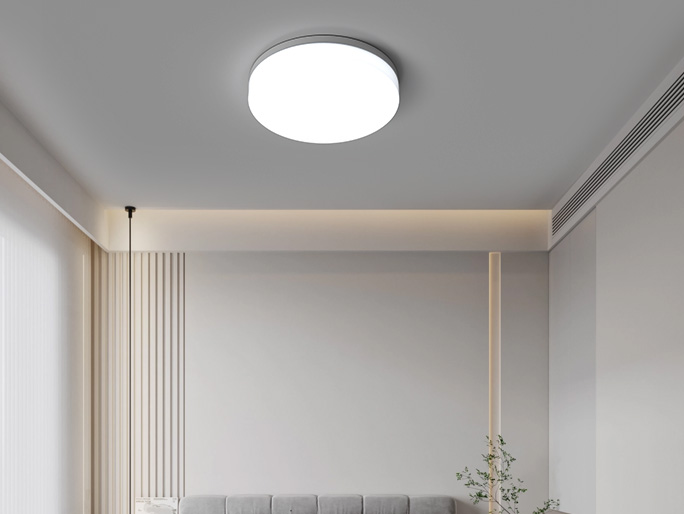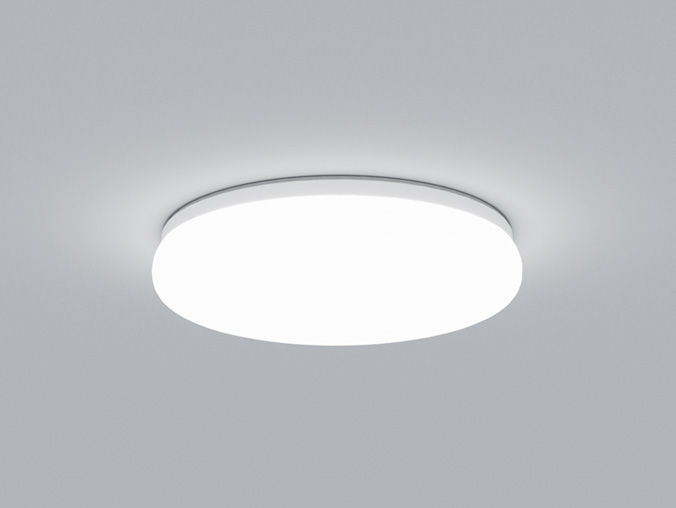

The best installation height for roof lights for ceiling depends on two core factors: the room’s ceiling height (low ≤2.4m, medium 2.4m–2.8m, high ≥2.8m) and the light’s type (recessed, surface-mounted, or semi-flush). Installing too low risks head bumps or glare, while too high may reduce light intensity and create dark corners. As a professional lighting brand, IMIGY’s Halo Ceiling Lights (recessed round led ceiling light) and Bean Ceiling Lights (surface-mounted room roof light) are designed to adapt to different heights, with clear installation guidelines to ensure optimal brightness and safety. Below is a detailed breakdown of recommended heights, product advantages, and practical tips.

1. Recommended Heights by Ceiling Height
a. Low Ceilings (≤2.4m)
For low ceilings, roof lights for ceiling should be surface-mounted or shallow-recessed to avoid reducing vertical space. IMIGY’s Bean Ceiling Lights (a compact surface-mounted round ceiling light) have a thickness of only 8cm—installing them directly on the ceiling (no extra gap) keeps the light 2.4m from the floor, eliminating head bump risks. A user with a 2.3m bedroom ceiling noted: “Bean’s low profile means I never hit my head, and the light still covers the entire room evenly.”
Avoid recessed lights requiring deep ceiling cuts (≥10cm) — they may lower the effective ceiling height further. If using recessed models like Halo, choose the shallow-recessed version (depth ≤6cm) and ensure the light’s bottom edge aligns with the ceiling surface.

b. Medium Ceilings (2.4m–2.8m)
Medium ceilings balance flexibility—both recessed and surface-mounted room ceiling light work well. Halo Ceiling Lights (recessed round led ceiling light) are ideal here: recessing them 3cm–5cm into the ceiling keeps the light 2.5m–2.7m from the floor, ensuring brightness reaches the entire space without glare. For example, in a 2.6m living room, Halo’s 120° beam angle covers 15–20㎡ when installed at this height.
Bean can also be used here—surface-mounted installation keeps it 2.4m–2.8m from the floor, and its adjustable brightness (10%–100%) lets you compensate for slight height differences.
c. High Ceilings (≥2.8m)
High ceilings require room ceiling light with strong light penetration or semi-flush mounting to bring light closer to the floor. Halo’s recessed design with a 1500-lumen output (for larger models) works well—installing it at the standard recess depth (5cm) keeps the light 2.7m–2.9m from the floor, and its focused beam avoids wasting light on high ceilings. For lofts or living rooms with 3m ceilings, pairing 2–3 Halo lights (spaced 1.5m apart) ensures even illumination.
Avoid small surface-mounted lights like Bean here—their 800-lumen output may be too weak for high ceilings, leading to dim corners.
2. IMIGY Products’ Advantages for Height Adaptation
a. Halo Ceiling Lights (Recessed, Flexible Depth)
Adjustable Recess Depth: Halo’s recessed design supports 3cm–8cm depth adjustment—deeper for high ceilings (to bring light down) and shallower for low ceilings (to save space). This flexibility makes it a universal choice for all ceiling heights, unlike fixed-depth recessed lights (which only fit medium heights).
Strong Beam Penetration: Halo’s 120°–150° beam angle and high lumen output (800–1500lm) ensure light reaches the floor even in 3m high ceilings, avoiding the “dim middle” issue common in weak recessed lights.
b. Bean Ceiling Lights (Surface-Mounted, Low Profile)
Ultra-Thin Design: Bean’s 8cm thickness is 30% thinner than standard surface-mounted room roof light (≥12cm). This makes it the top choice for low ceilings, as it doesn’t add visual bulk or reduce usable space. A user with a 2.2m entryway ceiling shared: “Bean looks like it’s floating on the ceiling—no bulky fixture making the space feel cramped.”
Light Diffusion Optimization: Bean’s frosted PC diffuser spreads light evenly, even when installed at 2.3m (low ceiling)—no harsh glare on faces, unlike surface-mounted lights with narrow beam angles.
3. Practical Tips to Ensure Correct Installation
a. Use a Level to Confirm Height Consistency
For multiple roof lights for ceiling (e.g., 2–3 Halos in a living room), use a level to ensure all lights are installed at the same height. Even a 1cm difference can create uneven light distribution and look unprofessional.
b. Consider Furniture Height
Install round ceiling light above key furniture (e.g., sofas, beds) at a height that avoids glare on seated/reclined people. For example, above a 0.8m high sofa in a 2.6m room, install Halo 2.5m from the floor—this keeps the light 1.7m above the sofa, preventing glare on faces during reading.
4. Common Misconceptions to Avoid
“Higher installation = better coverage”: No—installing too high (e.g., 3m for a 2.8m ceiling) reduces light intensity at eye level, making the room feel dim.
“All surface-mounted lights are for low ceilings”: Bean works for medium ceilings too—its brightness and diffusion compensate for height, unlike cheap surface-mounted lights with weak output.
The best installation height for roof lights for ceiling ranges from 2.3m–2.9m, depending on ceiling height and light type. IMIGY’s Halo Ceiling Lights (recessed, adaptable depth) excel in medium-to-high ceilings, while Bean Ceiling Lights (surface-mounted, low profile) are perfect for low ceilings. Both models ensure safety (no head bumps), optimal brightness, and visual harmony with the room. If you’re unsure about your ceiling height or furniture layout, contact IMIGY—we’ll provide a customized installation plan for your room ceiling light, ensuring your round led ceiling light delivers the best performance for your space.
It is recommended that you upgrade the latest browser
 Chrome
Chrome Firefox
Firefox Edge
Edge